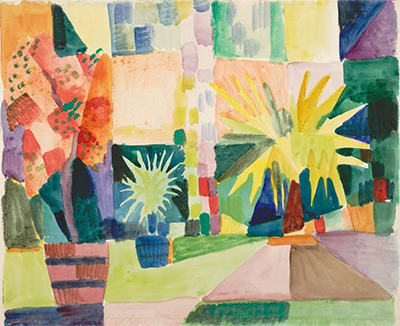Ever since around the 17th century there have been artists capturing the beauty of Lake Thun and August Macke would become one of the very artists during a period of a number of years. There have been a real variety of styles used to depict this stunning setting.
Landscape art, previous to around the 17th century, was not an accepted art form in Europe, with those able to produce such scenes forced to use them as supporting features in the background. You will find examples of that in the work of Giorgione and Lucas Cranach, whilst Hieronymus Bosch and Pieter Bruegel would adorn their landscapes with active figures to form their own early versions of this genre. The arrival of Romanticist artists such as Claude Lorrain and JMW Turner would then help this art form to finally achieve academic acceptance, opening doors for many other artists that followed on afterwards. Macke was by no means solely a landscape painter, but nature did play a major role in many of his paintings.
A glance at this painting will quickly reveal to you that it was completed in watercolours and the artist chose to use this medium when travelling because of the easy way in which the tools required could be transported around. In other cases he would produce study drawings that could then be used as a basis for oil paintings once he had returned to the comfort of his studio. He followed the same process when visiting North Africa which would provide him with a similar level of inspiration to the lake found here. For this watercolour he would have drawn out the scene using faint lines of pencil before then adding blocks of colour to each sectioned region of the composition.
The painting is now owned by the Albertina Museum in Vienna and is dated at 1914. Plants take centre stage in this artwork, with star shaped shapes appearing almost like sun and stars. In the top left we can identify elements of the background scene in a sort of terracotta brown with some touches of pink. The overall atmostphere is bright and uplifting, with the artist managing to communicate the beauty of this region, despite using such abstract forms. He went on to produce a number of other similarly titled landscape scenes during this extended visit to this popular region. The scene was put on cardboard and featured a Pomegranate Tree and Palm.




